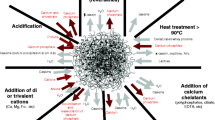Abstract
The oxidative degradation of phospholipids in the presence and absence of plasmalogens (plasmenyl phosphatidylethanolamine: PPE) was followed by chemical analysis. Human platelet phospholipids, either intact or after removal of PPE by acid treatment, were oxidized with 28 mM 2,2′-azobis(2-amidinopropane di-HCl in Triton X-100 micelles (detergent/phospholipid 5∶1, mol/mol). PPE (12% of all phospholipids, mol/mol) disappeared about three times more rapidly than glycerophospholipids, whereas sphingomyelin remained unaltered and the lysophosphatidylethanolamine (lysoPE) generated became progressively more unsaturated. After 60 min oxidation, the FA compositions of PS, PC, and PI were similar in extracts with or without plasmalogens. In contrast, diacyl phosphatidylethanolamine (DPE) became more saturated in the absence of PPE. The rate of phospholipid destruction was always unique to each class, but for all phospholipids slowed down in the presence of PPE. This protective effect increased in the order DPE<PS<PC<PI and did not seem to be simply related to the class unsaturation. α-Tocopherol had no influence on the time courses of the quantities and compositions of the phospholipids, even at a molar ratio of α-tocopherol to phospholipids four times higher than in platelet membranes. Thus, PPE protected phospholipids efficiently but differentially against peroxidative attack, whereas the contribution of α-tocopherol appeared to be negligible even at a concentration four times greater than in platelet membranes.
Similar content being viewed by others
Abbreviations
- AAPH:
-
2,2′-azobis(2-amidinopropane) di-HCl
- DPE:
-
diacyl phosphatidylethanolamine
- lysoPE:
-
lysophosphatidylethanolamine
- PPE:
-
plasmenyl phosphatidylethanolamine (plasmalogens)
- SM:
-
sphingomyelin
References
Iuliano, L., Colavita, A.R., Leo, R., Pratico, D., and Violi, F. (1997) Oxygen Free Radicals and Platelet Activation, Free Rad. Biol. Med. 22, 999–1006.
Joseph, M. (1995) The Generation of Free Radicals by Blood Platelets, in Handbook of Immunopharmacology (Joseph, M., ed.), pp. 209–225, Academic Press, London.
Brosche, T., and Platt, D. (1998) The Biological Significance of Plasmalogens in Defense Against Oxidative Damage, Exp. Gerontol. 33, 363–369.
Bolli, R., Patel, B.S., Jeroudi, M.O., Lai, E.K., and McCay, P.B. (1988) Demonstration of Free Radical Generation in “Stunned” Myocardium of Intact Dogs with the Use of the Spin Trap α-Phenyl N-tert-Butyl Nitrone, J. Clin. Invest. 82, 476–485.
Yavin, E., and Gatt, S. (1972) Oxygen-Dependent Cleavage of the Vinyl-Ether Linkage of Plasmalogens 1. Cleavage by Rat-Brain Supernatant, Eur. J. Biochem. 25, 431–436.
Garg, M.L., and Haerdi, J.C. (1993) The Biosynthesis and Functions of Plasmalogens, J. Clin. Biochem. Nutr. 14, 71–82.
Lee, T.C. (1998) Biosynthesis and Possible Biological Functions of Plasmalogens, Biochim. Biophys. Acta 1394, 129–145.
Morand, O.H., Zoeller, R.A., and Raetz, C.R.H. (1988) Disappearance of Plasmalogens from Membranes of Animal Cells Subjected to Photosensitized Oxidation, J. Biol. Chem. 263, 11597–11606.
Zoeller, R.A., Lake, A.C., Nagan, N., Gaposchkin, D.P., Legner, M.A., and Lieberthal, W. (1999) Plasmalogens as Endogenous Antioxidants: Somatic Cell Mutants Reveal the Importance of the Vinyl Ether, Biochem. J. 338, 769–776.
Engelmann, B., Brautigam, C., and Thiery, J. (1994) Plasmalogen Phospholipids as Potential Protectors Against Lipid Peroxidation of Low Density Lipoproteins, Biochem. Biophys. Res. Comm. 204, 1235–1242.
Felde, R., and Spiteller, G. (1995) Plasmalogen Oxidation in Human Serum Lipoproteins, Chem. Phys. Lipids 76, 259–267.
Hahnel, D., Beyer, K., and Engelmann, B. (1999) Inhibition of Peroxyl Radical-Mediated Lipid Oxidation by Plasmalogen Phospholipids and α-Tocopherol, Free Rad. Biol. Med. 27, 1087–1094.
Zommara, M., Tachibana, N., Mitsui, K., Nakatani, N., Sakono, M., Ikeda, I., and Imaizumi, K. (1995) Inhibitory Effect of Ethanolamine Plasmalogen on Iron- and Copper-Dependent Lipid Peroxidation, Free Rad. Biol. Med. 18, 599–602.
Khaselev, N., and Murphy, R.C. (1999) Susceptibility of Plasmenyl Glycerophosphoethanolamine Lipids Containing Arachidonate to Oxidative Degradation, Free Rad. Biol. Med. 26, 275–284.
Sindelar, P.J., Guan, Z., Dallner, G., and Ernster, L. (1999) The Protective Role of Plasmalogens in Iron-Induced Lipid Peroxidation, Free Rad. Biol. Med. 26, 318–324.
Reiss, D., Beyer, K., and Engelmann, B. (1997) Delayed Oxidative Degradation of Polyunsaturated Diacyl Phospholipids in the Presence of Plasmalogen Phospholipids in vitro, Biochem. J. 323, 807–814.
Takamura, H., Tanaka, K.I., Matsuura, T., and Kito, M. (1989) Ether Phospholipid Molecular Species in Human Platelets, J. Biochem. 105, 168–172.
Cazenave, J.P., Hemmendinger, S., Beretz, A., Sutter-Bay, A., and Launay, J. (1983) L’agrégation plaquettaire: Outil d’investigation clinique et étude pharmacologique. Méthodologie, Ann. Biol. Clin. 41, 167–179.
Leray, C., Andriamampandry, M., Gutbier, G., Cavadenti, J., Klein-Soyer, C., Gachet, C., and Cazenave, J.P. (1997) Quantitative Analysis of Vitamin E, Cholesterol and Phospholipid Fatty Acids in a Single Aliquot of Human Platelets and Cultured Endothelial Cells, J. Chromatogr. 696, 33–42.
Pugh, E.L., Kates, M., and Hanahan, D.J. (1977) Characterization of the Alkyl Ether Species of Phosphatidylcholine in Bovine Heart, J. Lipid Res. 18, 710–716.
Leray, C., Pelletier, X., Hemmendinger, S., and Cazenave, J.P. (1987) Thin-Layer Chromatography of Human Platelet Phospholipids with Fatty Acid Analysis, J. Chromatogr. 420, 411–416.
Khaselev, N., and Murphy, R.C. (2000) Structural Characterization of Oxidized Phospholipid Products Derived from Arachidonate-Containing Plasmenyl Glycerophosphocholine, J. Lipid Res. 41, 564–572.
Wang, J.Y., Shibata, T., Ueki, T., and Miyazawa, T. (1995) Susceptibility for Hydroperoxide Formation of Phosphatidylcholine and Phosphatidylethanolamine in Liposomes, J. Nutr. Sci. Vitaminol. (Tokyo) 41, 273–280.
Author information
Authors and Affiliations
Corresponding author
About this article
Cite this article
Leray, C., Cazenave, JP. & Gachet, C. Platelet phospholipids are differentially protected against oxidative degradation by plasmalogens. Lipids 37, 285–290 (2002). https://doi.org/10.1007/s11745-002-0892-4
Received:
Revised:
Accepted:
Issue Date:
DOI: https://doi.org/10.1007/s11745-002-0892-4




